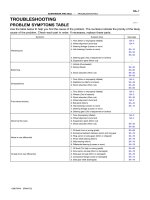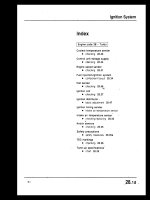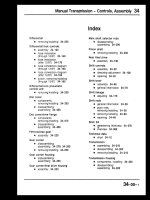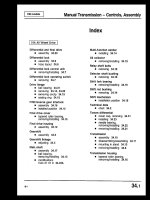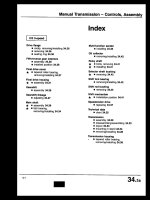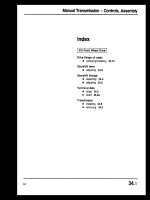IP BẢNG điều KHIỂN TRÊN NISSAN VERSA SEDAN 2012
Bạn đang xem bản rút gọn của tài liệu. Xem và tải ngay bản đầy đủ của tài liệu tại đây (2.04 MB, 26 trang )
IP-1
BODY INTERIOR
C
D
E
F
G
H
I
K
L
M
SECTION IP
A
B
IP
N
O
P
CONTENTS
INSTRUMENT PANEL
PRECAUTION 2
PRECAUTIONS 2
Precaution for Supplemental Restraint System
(SRS) "AIR BAG" and "SEAT BELT PRE-TEN-
SIONER"
2
Precaution for Work 2
PREPARATION 3
PREPARATION 3
Special Service Tools 3
Commercial Service Tools 3
CLIP LIST 4
Descriptions for Clips 4
SYMPTOM DIAGNOSIS 8
SQUEAK AND RATTLE TROUBLE DIAG-
NOSES
8
Work Flow 8
Generic Squeak and Rattle Troubleshooting 10
Diagnostic Worksheet 12
REMOVAL AND INSTALLATION 14
INSTRUMENT PANEL ASSEMBLY 14
Exploded View 14
Removal and Installation 15
STEERING COLUMN COVERS 18
Removal and Installation 18
CLUSTER LID A 19
Removal and Installation 19
INSTRUMENT LOWER PANEL LH 20
Removal and Installation 20
CLUSTER LID C 21
Removal and Installation 21
GLOVE BOX ASSEMBLY AND HOUSING 22
Removal and Installation 22
CENTER CONSOLE ASSEMBLY 23
Exploded View 23
Removal and Installation 23
CENTER CONSOLE LOWER 25
Removal and Installation 25
UNIT DISASSEMBLY AND ASSEMBLY 26
CENTER CONSOLE ASSEMBLY 26
Exploded View 26
Disassembly and Assembly 26
Revision: July 2011 2012 Versa Sedan
IP-2
< PRECAUTION >
PRECAUTIONS
PRECAUTION
PRECAUTIONS
Precaution for Supplemental Restraint System (SRS) "AIR BAG" and "SEAT BELT
PRE-TENSIONER"
INFOID:0000000007673967
The Supplemental Restraint System such as “AIR BAG” and “SEAT BELT PRE-TENSIONER”, used along
with a front seat belt, helps to reduce the risk or severity of injury to the driver and front passenger for certain
types of collision. This system includes seat belt switch inputs and dual stage front air bag modules. The SRS
system uses the seat belt switches to determine the front air bag deployment, and may only deploy one front
air bag, depending on the severity of a collision and whether the front occupants are belted or unbelted.
Information necessary to service the system safely is included in the SR and SB section of this Service Man-
ual.
WARNING:
• To avoid rendering the SRS inoperative, which could increase the risk of personal injury or death in
the event of a collision which would result in air bag inflation, all maintenance must be performed by
an authorized NISSAN/INFINITI dealer.
• Improper maintenance, including incorrect removal and installation of the SRS, can lead to personal
injury caused by unintentional activation of the system. For removal of Spiral Cable and Air Bag
Module, see the SR section.
• Do not use electrical test equipment on any circuit related to the SRS unless instructed to in this
Service Manual. SRS wiring harnesses can be identified by yellow and/or orange harnesses or har-
ness connectors.
PRECAUTIONS WHEN USING POWER TOOLS (AIR OR ELECTRIC) AND HAMMERS
WARNING:
• When working near the Airbag Diagnosis Sensor Unit or other Airbag System sensors with the Igni-
tion ON or engine running, DO NOT use air or electric power tools or strike near the sensor(s) with a
hammer. Heavy vibration could activate the sensor(s) and deploy the air bag(s), possibly causing
serious injury.
• When using air or electric power tools or hammers, always switch the Ignition OFF, disconnect the
battery, and wait at least 3 minutes before performing any service.
Precaution for Work INFOID:0000000007673966
• When removing or disassembling each component, be careful not to damage or deform it. If a component
may be subject to interference, be sure to protect it with a shop cloth.
• When removing (disengaging) components with a screwdriver or similar tool, be sure to wrap the component
with a shop cloth or vinyl tape to protect it.
• Protect the removed parts with a shop cloth and prevent them from being dropped.
• Replace a deformed or damaged clip.
• If a part is specified as a non-reusable part, always replace it with new one.
• Be sure to tighten bolts and nuts securely to the specified torque.
• After installation is complete, be sure to check that each part works properly.
• Follow the steps below to clean components.
- Water soluble dirt: Dip a soft cloth into lukewarm water, and wring the water out of the cloth to wipe the dirty
area.
Then rub with a soft and dry cloth.
- Oily dirt: Dip a soft cloth into lukewarm water with mild detergent (concentration: within 2 to 3%), and wipe
the dirty area.
Then dip a cloth into fresh water, and wring the water out of the cloth to wipe the detergent off. Then rub with
a soft and dry cloth.
• Do not use organic solvent such as thinner, benzene, alcohol, or gasoline.
• For genuine leather seats, use a genuine leather seat cleaner.
Revision: July 2011 2012 Versa Sedan
PREPARATION
IP-3
< PREPARATION >
C
D
E
F
G
H
I
K
L
M
A
B
IP
N
O
P
PREPARATION
PREPARATION
Special Service Tools INFOID:0000000007673973
The actual shapes of Kent-Moore tools may differ from those of special service tools illustrated here.
Commercial Service Tools INFOID:0000000007673974
Tool number
(Kent-Moore No.)
Tool name
Description
—
(J-39570)
Chassis ear
Locating the noise
—
(J-43980)
NISSAN Squeak and Rattle
Kit
Repairing the cause of noise
—
(J-46534)
Trim Tool Set
Removing trim components
SIIA0993E
SIIA0994E
AWJIA0483ZZ
Tool name Description
Engine ear Locating the noise
Power tool Loosening bolts, nuts and screws
SIIA0995E
PIIB1407E
Revision: July 2011 2012 Versa Sedan
IP-4
< PREPARATION >
CLIP LIST
CLIP LIST
Descriptions for Clips INFOID:0000000007768848
Replace any clips which are damaged during removal or installation.
SIIA0315E
Revision: July 2011 2012 Versa Sedan
CLIP LIST
IP-5
< PREPARATION >
C
D
E
F
G
H
I
K
L
M
A
B
IP
N
O
P
SIIA0316E
Revision: July 2011 2012 Versa Sedan
IP-6
< PREPARATION >
CLIP LIST
SIIA0317E
Revision: July 2011 2012 Versa Sedan
CLIP LIST
IP-7
< PREPARATION >
C
D
E
F
G
H
I
K
L
M
A
B
IP
N
O
P
ALJIA0564GB
Revision: July 2011 2012 Versa Sedan
IP-8
< SYMPTOM DIAGNOSIS >
SQUEAK AND RATTLE TROUBLE DIAGNOSES
SYMPTOM DIAGNOSIS
SQUEAK AND RATTLE TROUBLE DIAGNOSES
Work Flow INFOID:0000000007673968
CUSTOMER INTERVIEW
Interview the customer if possible, to determine the conditions that exist when the noise occurs. Use the Diag-
nostic Worksheet during the interview to document the facts and conditions when the noise occurs and any
customer's comments; refer to IP-12, "
Diagnostic Worksheet". This information is necessary to duplicate the
conditions that exist when the noise occurs.
• The customer may not be able to provide a detailed description or the location of the noise. Attempt to obtain
all the facts and conditions that exist when the noise occurs (or does not occur).
• If there is more than one noise in the vehicle, be sure to diagnose and repair the noise that the customer is
concerned about. This can be accomplished by test driving the vehicle with the customer.
• After identifying the type of noise, isolate the noise in terms of its characteristics. The noise characteristics
are provided so the customer, service adviser and technician are all speaking the same language when
defining the noise.
• Squeak —(Like tennis shoes on a clean floor)
Squeak characteristics include the light contact/fast movement/brought on by road conditions/hard surfaces
= higher pitch noise/softer surfaces = lower pitch noises/edge to surface = chirping.
• Creak—(Like walking on an old wooden floor)
Creak characteristics include firm contact/slow movement/twisting with a rotational movement/pitch depen-
dent on materials/often brought on by activity.
• Rattle—(Like shaking a baby rattle)
Rattle characteristics include the fast repeated contact/vibration or similar movement/loose parts/missing
clip or fastener/incorrect clearance.
• Knock —(Like a knock on a door)
Knock characteristics include hollow sounding/sometimes repeating/often brought on by driver action.
• Tick—(Like a clock second hand)
Tick characteristics include gentle contacting of light materials/loose components/can be caused by driver
action or road conditions.
• Thump—(Heavy, muffled knock noise)
Thump characteristics include softer knock/dead sound often brought on by activity.
• Buzz—(Like a bumble bee)
Buzz characteristics include high frequency rattle/firm contact.
• Often the degree of acceptable noise level will vary depending upon the person. A noise that you may judge
as acceptable may be very irritating to the customer.
• Weather conditions, especially humidity and temperature, may have a great effect on noise level.
DUPLICATE THE NOISE AND TEST DRIVE
SBT842
Revision: July 2011 2012 Versa Sedan
SQUEAK AND RATTLE TROUBLE DIAGNOSES
IP-9
< SYMPTOM DIAGNOSIS >
C
D
E
F
G
H
I
K
L
M
A
B
IP
N
O
P
If possible, drive the vehicle with the customer until the noise is duplicated. Note any additional information on
the Diagnostic Worksheet regarding the conditions or location of the noise. This information can be used to
duplicate the same conditions when you confirm the repair.
If the noise can be duplicated easily during the test drive, to help identify the source of the noise, try to dupli-
cate the noise with the vehicle stopped by doing one or all of the following:
1) Close a door.
2) Tap or push/pull around the area where the noise appears to be coming from.
3) Rev the engine.
4) Use a floor jack to recreate vehicle “twist”.
5) At idle, apply engine load (electrical load, half-clutch on M/T model, drive position on CVT and A/T models).
6) Raise the vehicle on a hoist and hit a tire with a rubber hammer.
• Drive the vehicle and attempt to duplicate the conditions the customer states exist when the noise occurs.
• If it is difficult to duplicate the noise, drive the vehicle slowly on an undulating or rough road to stress the
vehicle body.
CHECK RELATED SERVICE BULLETINS
After verifying the customer concern or symptom, check ASIST for Technical Service Bulletins (TSBs) related
to that concern or symptom.
If a TSB relates to the symptom, follow the procedure to repair the noise.
LOCATE THE NOISE AND IDENTIFY THE ROOT CAUSE
1. Narrow down the noise to a general area. To help pinpoint the source of the noise, use a listening tool
(Chassis Ear: J-39570, Engine Ear: J-39565 and mechanic's stethoscope).
2. Narrow down the noise to a more specific area and identify the cause of the noise by:
• removing the components in the area that you suspect the noise is coming from.
Do not use too much force when removing clips and fasteners, otherwise clips and fasteners can be
broken or lost during the repair, resulting in the creation of new noise.
• tapping or pushing/pulling the component that you suspect is causing the noise.
Do not tap or push/pull the component with excessive force, otherwise the noise will be eliminated only
temporarily.
• feeling for a vibration with your hand by touching the component(s) that you suspect is (are) causing the
noise.
• placing a piece of paper between components that you suspect are causing the noise.
• looking for loose components and contact marks.
Refer to IP-10, "
Generic Squeak and Rattle Troubleshooting".
REPAIR THE CAUSE
• If the cause is a loose component, tighten the component securely.
• If the cause is insufficient clearance between components:
- separate components by repositioning or loosening and retightening the component, if possible.
- insulate components with a suitable insulator such as urethane pads, foam blocks, felt cloth tape or urethane
tape. A NISSAN Squeak and Rattle Kit (J-43980) is available through your authorized NISSAN Parts Depart-
ment.
CAUTION:
Do not use excessive force as many components are constructed of plastic and may be damaged.
Always check with the Parts Department for the latest parts information.
The following materials are contained in the NISSAN Squeak and Rattle Kit (J-43980). Each item can be
ordered separately as needed.
URETHANE PADS [1.5 mm (0.059 in) thick]
Insulates connectors, harness, etc.
76268-9E005: 100×135 mm (3.94×5.31 in)/76884-71L01: 60×85 mm (2.36×3.35 in)/76884-71L02: 15×25
mm (0.59×0.98 in)
INSULATOR (Foam blocks)
Insulates components from contact. Can be used to fill space behind a panel.
73982-9E000: 45 mm (1.77 in) thick, 50×50 mm (1.97×1.97 in)/73982-50Y00: 10 mm (0.39 in) thick,
50×50 mm (1.97×1.97 in)
INSULATOR (Light foam block)
80845-71L00: 30 mm (1.18 in) thick, 30×50 mm (1.18×1.97 in)
FELT CLOTH TAPE
Used to insulate where movement does not occur. Ideal for instrument panel applications.
68370-4B000: 15×25 mm (0.59×0.98 in) pad/68239-13E00: 5 mm (0.20 in) wide tape roll. The following
materials not found in the kit can also be used to repair squeaks and rattles.
Revision: July 2011 2012 Versa Sedan
IP-10
< SYMPTOM DIAGNOSIS >
SQUEAK AND RATTLE TROUBLE DIAGNOSES
UHMW (TEFLON) TAPE
Insulates where slight movement is present. Ideal for instrument panel applications.
SILICONE GREASE
Used instead of UHMW tape that will be visible or not fit.
Note: Will only last a few months.
SILICONE SPRAY
Use when grease cannot be applied.
DUCT TAPE
Use to eliminate movement.
CONFIRM THE REPAIR
Confirm that the cause of a noise is repaired by test driving the vehicle. Operate the vehicle under the same
conditions as when the noise originally occurred. Refer to the notes on the Diagnostic Worksheet.
Generic Squeak and Rattle Troubleshooting INFOID:0000000007673969
Refer to Table of Contents for specific component removal and installation information.
INSTRUMENT PANEL
Most incidents are caused by contact and movement between:
1. The cluster lid A and instrument panel
2. Acrylic lens and combination meter housing
3. Instrument panel to front pillar garnish
4. Instrument panel to windshield
5. Instrument panel pins
6. Wiring harnesses behind the combination meter
7. A/C defroster duct and duct joint
These incidents can usually be located by tapping or moving the components to duplicate the noise or by
pressing on the components while driving to stop the noise. Most of these incidents can be repaired by apply-
ing felt cloth tape or silicone spray (in hard to reach areas). Urethane pads can be used to insulate wiring har-
ness.
CAUTION:
Do not use silicone spray to isolate a squeak or rattle. If you saturate the area with silicone, you will
not be able to recheck the repair.
CENTER CONSOLE
Components to pay attention to include:
1. Shift selector assembly cover to finisher
2. A/C control unit and cluster lid C
3. Wiring harnesses behind audio and A/C control unit
The instrument panel repair and isolation procedures also apply to the center console.
DOORS
Pay attention to the:
1. Finisher and inner panel making a slapping noise
2. Inside handle escutcheon to door finisher
3. Wiring harnesses tapping
4. Door striker out of alignment causing a popping noise on starts and stops
Tapping or moving the components or pressing on them while driving to duplicate the conditions can isolate
many of these incidents. You can usually insulate the areas with felt cloth tape or insulator foam blocks from
the NISSAN Squeak and Rattle Kit (J-43980) to repair the noise.
TRUNK
Trunk noises are often caused by a loose jack or loose items put into the trunk by the owner.
In addition look for:
1. Trunk lid bumpers out of adjustment
2. Trunk lid striker out of adjustment
3. The trunk lid torsion bars knocking together
Revision: July 2011 2012 Versa Sedan
SQUEAK AND RATTLE TROUBLE DIAGNOSES
IP-11
< SYMPTOM DIAGNOSIS >
C
D
E
F
G
H
I
K
L
M
A
B
IP
N
O
P
4. A loose license plate or bracket
Most of these incidents can be repaired by adjusting, securing or insulating the item(s) or component(s) caus-
ing the noise.
SUNROOF/HEADLINING
Noises in the sunroof/headlining area can often be traced to one of the following:
1. Sunroof lid, rail, linkage or seals making a rattle or light knocking noise
2. Sun visor shaft shaking in the holder
3. Front or rear windshield touching headliner and squeaking
Again, pressing on the components to stop the noise while duplicating the conditions can isolate most of these
incidents. Repairs usually consist of insulating with felt cloth tape.
OVERHEAD CONSOLE (FRONT AND REAR)
Overhead console noises are often caused by the console panel clips not being engaged correctly. Most of
these incidents are repaired by pushing up on the console at the clip locations until the clips engage.
In addition look for:
1. Loose harness or harness connectors.
2. Front console map/reading lamp lens loose.
3. Loose screws at console attachment points.
SEATS
When isolating seat noise it's important to note the position the seat is in and the load placed on the seat when
the noise is present. These conditions should be duplicated when verifying and isolating the cause of the
noise.
Cause of seat noise include:
1. Headrest rods and holder
2. A squeak between the seat pad cushion and frame
3. The rear seatback lock and bracket
These noises can be isolated by moving or pressing on the suspected components while duplicating the con-
ditions under which the noise occurs. Most of these incidents can be repaired by repositioning the component
or applying urethane tape to the contact area.
UNDERHOOD
Some interior noise may be caused by components under the hood or on the engine wall. The noise is then
transmitted into the passenger compartment.
Causes of transmitted underhood noise include:
1. Any component installed to the engine wall
2. Components that pass through the engine wall
3. Engine wall mounts and connectors
4. Loose radiator installation pins
5. Hood bumpers out of adjustment
6. Hood striker out of adjustment
These noises can be difficult to isolate since they cannot be reached from the interior of the vehicle. The best
method is to secure, move or insulate one component at a time and test drive the vehicle. Also, engine RPM
or load can be changed to isolate the noise. Repairs can usually be made by moving, adjusting, securing, or
insulating the component causing the noise.
Revision: July 2011 2012 Versa Sedan
IP-12
< SYMPTOM DIAGNOSIS >
SQUEAK AND RATTLE TROUBLE DIAGNOSES
Diagnostic Worksheet
INFOID:0000000007673970
LAIA0072E
Revision: July 2011 2012 Versa Sedan
SQUEAK AND RATTLE TROUBLE DIAGNOSES
IP-13
< SYMPTOM DIAGNOSIS >
C
D
E
F
G
H
I
K
L
M
A
B
IP
N
O
P
LAIA0071E
Revision: July 2011 2012 Versa Sedan
IP-14
< REMOVAL AND INSTALLATION >
INSTRUMENT PANEL ASSEMBLY
REMOVAL AND INSTALLATION
INSTRUMENT PANEL ASSEMBLY
Exploded View INFOID:0000000007207467
AWJIA0702GB
Revision: July 2011 2012 Versa Sedan
INSTRUMENT PANEL ASSEMBLY
IP-15
< REMOVAL AND INSTALLATION >
C
D
E
F
G
H
I
K
L
M
A
B
IP
N
O
P
Removal and Installation INFOID:0000000007207468
CAUTION:
• Disconnect both the negative and positive battery terminals, then wait at least three minutes.
• Never tamper with or force air bag lid open, as this may adversely affect air bag performance.
• To prevent damage to the parts, when removing, always use a suitable tool that is made of plastic.
• Be careful not to scratch instrument panel pad or other parts.
REMOVAL
1. Disconnect the negative and positive battery terminals, then wait at least three minutes.
2. Remove front pillar finishers (LH/RH). Refer to INT-19, "
FRONT PILLAR FINISHER : Removal and Instal-
lation".
3. Remove dash side finishers (LH/RH). Refer to INT-21, "
DASH SIDE FINISHER : Removal and Installa-
tion".
4. Partially remove front body side welts (LH/RH). Refer to INT-22, "
BODY SIDE WELT : Removal and
Installation".
5. Release the pawls using a suitable tool and then remove instru-
ment side finisher LH by pulling rearward.
: Pawl
6. Release the pawls using a suitable tool and then remove instru-
ment side finisher RH by pulling rearward.
: Pawl
7. Remove center console lower. Refer to IP-25, "
Removal and Installation".
8. Remove steering wheel. Refer to ST-7, "
Removal and Installation".
9. Remove steering column covers. Refer to IP-18, "
Removal and Installation".
10. Remove combination switch. Refer to EXL-85, "
Removal and Installation".
11. Remove combination meter. Refer to MWI-52, "
Removal and Installation" (TYPE A) or MWI-101,
"Removal and Installation" (TYPE B).
1. Instrument side finisher RH 2. Passenger air bag module 3. Instrument panel assembly
4. Instrument side finisher LH 5. Combination meter 6. Cluster lid A
7. Instrument lower panel LH 8. Steering column upper cover 9. Steering column lower cover
10. Steering lock escutcheon 11. Center console lower 12. Control knob
13. A/C control finisher 14. Glove box lid 15. A/C control
16. Cluster lid C 17. Knee protector LH 18. Audio unit or AV control unit (if
equipped)
19. Glove box striker 20. Glove box Metal clip
Clip Pawl
AWJIA0712ZZ
AWJIA0713ZZ
Revision: July 2011 2012 Versa Sedan
IP-16
< REMOVAL AND INSTALLATION >
INSTRUMENT PANEL ASSEMBLY
12. Remove cluster lid C. Refer to IP-21, "Removal and Installation".
13. Remove audio unit, refer to AV-25, "
Removal and Installation" (BASE AUDIO) or AV-74, "Removal and
Installation" (MID AUDIO) or remove AV control unit, refer to AV-135, "Removal and Installation" (PRE-
MIUM AUDIO).
14. Remove A/C control finisher.
a. Remove intake door lever knob (1).
b. Pull left side of A/C control finisher (2) rearward to release left
side metal clips.
: Metal clip
c. Pull right side of A/C control finisher (2) rearward to release right
side metal clips and remove A/C control finisher.
: Metal clip
15. Remove A/C control. Refer to HAC-45, "
Removal and Installation".
16. Remove glove box assembly. Refer to IP-22, "
Removal and Installation".
17. Remove passenger air bag module. Refer to SR-10, "
Removal and Installation".
18. Remove instrument panel assembly.
a. Remove instrument panel assembly screws (A).
b. Disengage the harness (A, B) from the instrument panel assembly at the base of each front pillar.
c. Remove instrument panel assembly through passenger door opening.
CAUTION:
• Cover shift selector assembly with a shop cloth to prevent damage to instrument panel assem-
bly.
• When removing instrument panel assembly, two workers are required to prevent it from drop-
ping.
19. Removal of the following components is only necessary if replacing the instrument panel assembly.
AWJIA0710ZZ
AWJIA0711ZZ
JMJIA6065ZZ
Revision: July 2011 2012 Versa Sedan
INSTRUMENT PANEL ASSEMBLY
IP-17
< REMOVAL AND INSTALLATION >
C
D
E
F
G
H
I
K
L
M
A
B
IP
N
O
P
• Side ventilator grilles (LH/RH): Refer to VTL-7, "SIDE VENTILATOR GRILLE : Removal and Installa-
tion".
• Center ventilator duct LH/RH: Refer to VTL-7, "
CENTER VENTILATOR DUCT : Removal and Installa-
tion".
INSTALLATION
Installation is in the reverse order of removal.
CAUTION:
• Do not reuse the steering wheel nut after removal, replace with a new nut.
• Do not reuse the passenger air bag bolts after removal, replace with new bolts.
Revision: July 2011 2012 Versa Sedan
IP-18
< REMOVAL AND INSTALLATION >
STEERING COLUMN COVERS
STEERING COLUMN COVERS
Removal and Installation INFOID:0000000007631295
REMOVAL
1. Remove instrument lower panel LH. Refer to IP-20, "Removal and Installation".
2. Remove knee protector LH bolts and knee protector LH. Refer to IP-14, "
Exploded View".
3. Remove steering column covers.
a. Remove steering column cover screws (A).
b. Tilt the steering column to the lowest position.
c. Pull steering column upper cover (1) upward to disengage steer-
ing column upper cover pawls.
: Pawl
d. Remove steering column upper cover.
e. Pull steering column lower cover (2) downward to remove.
INSTALLATION
Installation is in the reverse order of removal.
AWJIA0707ZZ
Revision: July 2011 2012 Versa Sedan
CLUSTER LID A
IP-19
< REMOVAL AND INSTALLATION >
C
D
E
F
G
H
I
K
L
M
A
B
IP
N
O
P
CLUSTER LID A
Removal and Installation INFOID:0000000007631291
REMOVAL
1. Remove steering column covers. Refer to IP-18, "Removal and Installation".
2. Remove cluster lid C. Refer to IP-21, "
Removal and Installation".
3. Remove cluster lid A.
a. Remove combination meter finisher and cluster lid A as an assembly by pulling rearward to release pawls
and metal clips.
•: Pawl
•: Metal clip
b. If necessary, separate cluster lid A (2) from combination meter finisher (1) by releasing the metal clips.
INSTALLATION
Installation is in the reverse order of removal.
AWJIA0709ZZ
Revision: July 2011 2012 Versa Sedan
IP-20
< REMOVAL AND INSTALLATION >
INSTRUMENT LOWER PANEL LH
INSTRUMENT LOWER PANEL LH
Removal and Installation INFOID:0000000007631294
REMOVAL
1. Remove data link connector from instrument lower panel LH.
2. Remove hood and fuel filler handle assembly bolts (A) and posi-
tion hood and fuel filler handle assembly aside.
3. Remove instrument lower panel LH. Refer to IP-14, "
Exploded View".
a. Release instrument lower panel LH by using a suitable tool to release the pawls and metal clips and pull-
ing rearward.
CAUTION:
Disengage pawls and metal clips slowly so that they are not damaged.
b. Disconnect harness connectors and remove instrument lower panel LH.
INSTALLATION
Installation is in the reverse order of removal.
JMKIA7998ZZ
Revision: July 2011 2012 Versa Sedan
CLUSTER LID C
IP-21
< REMOVAL AND INSTALLATION >
C
D
E
F
G
H
I
K
L
M
A
B
IP
N
O
P
CLUSTER LID C
Removal and Installation INFOID:0000000007631292
REMOVAL
1. Release the metal clips using a suitable tool (A), beginning in
the lower left corner of cluster lid C and working in a counter-
clockwise direction.
: Metal clip
2. Reposition cluster lid C to access harness connectors.
3. Disconnect harness connectors and remove cluster lid C.
INSTALLATION
Installation is in the reverse order of removal.
JMJIA6055ZZ
Revision: July 2011 2012 Versa Sedan
IP-22
< REMOVAL AND INSTALLATION >
GLOVE BOX ASSEMBLY AND HOUSING
GLOVE BOX ASSEMBLY AND HOUSING
Removal and Installation INFOID:0000000007631293
REMOVAL
1. Remove glove box lid.
a. Open glove box lid.
b. Pull glove box lid rearward and glove box lid hinges down and
rearward to disengage, then remove the glove box lid.
2. Remove glove box assembly.
a. Remove glove box assembly screws (A).
b. Pull glove box assembly rearward to disengage pawls and
remove glove box assembly.
: Pawl
INSTALLATION
Installation is in the reverse order of removal.
JMJIA6060ZZ
AWJIA0714ZZ
Revision: July 2011 2012 Versa Sedan
CENTER CONSOLE ASSEMBLY
IP-23
< REMOVAL AND INSTALLATION >
C
D
E
F
G
H
I
K
L
M
A
B
IP
N
O
P
CENTER CONSOLE ASSEMBLY
Exploded View INFOID:0000000007207469
Removal and Installation INFOID:0000000007207470
REMOVAL
1. Move shift selector to “N” position (CVT models).
2. Remove shift selector handle and console boot (M/T models).
3. Raise parking brake lever.
4. Remove center console assembly clips (A).
5. Remove the center console assembly rear screws.
6. Slide front seat RH all the way backward and place in fully reclined position.
7. Slide front seat LH all the way forward and tilt seatback to the full forward position.
1. M/T console boot (M/T models) 2. Center console assembly
AWJIA0694ZZ
JMJIA6093ZZ
Revision: July 2011 2012 Versa Sedan
IP-24
< REMOVAL AND INSTALLATION >
CENTER CONSOLE ASSEMBLY
8. Raise rear right corner of center console assembly, rotating
slightly, making sure to lift assembly upward over the parking
brake handle.
9. Disconnect power socket connector and USB/auxiliary jack con-
nector (if equipped) and remove center console assembly.
INSTALLATION
Installation is in the reverse order of removal.
AWJIA0695ZZ
Revision: July 2011 2012 Versa Sedan
CENTER CONSOLE LOWER
IP-25
< REMOVAL AND INSTALLATION >
C
D
E
F
G
H
I
K
L
M
A
B
IP
N
O
P
CENTER CONSOLE LOWER
Removal and Installation INFOID:0000000007631290
REMOVAL
1. Remove center console assembly. Refer to IP-23, "Removal and Installation".
2. Remove center console lower.
a. Place front seats in a full rearward position.
b. Remove center console lower clips (A).
c. Disengage center console lower pawls and remove center con-
sole lower.
: Pawl
INSTALLATION
Installation is in the reverse order of removal.
JMJIA6052ZZ
AWJIA0706ZZ
Revision: July 2011 2012 Versa Sedan
